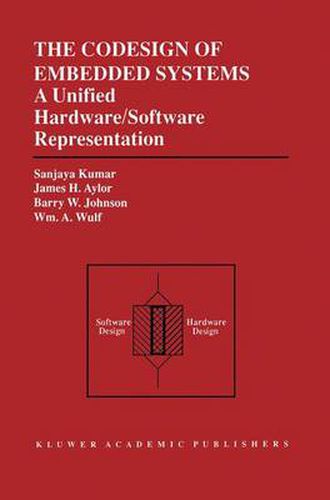Readings Newsletter
Become a Readings Member to make your shopping experience even easier.
Sign in or sign up for free!
You’re not far away from qualifying for FREE standard shipping within Australia
You’ve qualified for FREE standard shipping within Australia
The cart is loading…






This title is printed to order. This book may have been self-published. If so, we cannot guarantee the quality of the content. In the main most books will have gone through the editing process however some may not. We therefore suggest that you be aware of this before ordering this book. If in doubt check either the author or publisher’s details as we are unable to accept any returns unless they are faulty. Please contact us if you have any questions.
Current practice dictates the separation of the hardware and software development paths early in the design cycle. These paths remain independent with very little interaction occurring between them until system integration. In particular, hardware is often specified without fully appreciating the computational requirements of the software. Also, software development does not influence hardware development and does not track changes made during the hardware design phase. Thus, the ability to explore hardware/software tradeoffs is restricted, such as the movement of functionality from the software domain to the hardware domain (and vice-versa) or the modification of the hardware/software interface. As a result, problems that are encountered during system integration may require modification of the software and/or hardware, resulting in potentially significant cost increases and schedule overruns.
To address the problems described above, a cooperative design approach, one that utilizes a unified view of hardware and software, is described. This approach is called hardware/software codesign. The Codesign of Embedded Systems develops several fundamental hardware/software codesign concepts and a methodology that supports them. A unified representation, referred to as a decomposition graph, is presented which can be used to describe hardware or software using either functional abstractions or data abstractions. Using a unified representation based on functional abstractions, an abstract hardware/software model has been implemented in a common simulation environment called ADEPT (Advanced Design Environment Prototyping Tool). This model permits early hardware/software evaluation and tradeoff exploration. Techniques have been developed which support the identification of software bottlenecks and the evaluation of design alternatives with respect to multiple metrics. The application of the model is demonstrated on several examples. A unified representation based on data abstractions is also explored. This work leads to investigations regarding the application of object-oriented techniques to hardware design.
The Codesign of Embedded Systems: A Unified Hardware/Software Representation describes a novel approach to a topic of immense importance to CAD researchers and designers alike.
$9.00 standard shipping within Australia
FREE standard shipping within Australia for orders over $100.00
Express & International shipping calculated at checkout
This title is printed to order. This book may have been self-published. If so, we cannot guarantee the quality of the content. In the main most books will have gone through the editing process however some may not. We therefore suggest that you be aware of this before ordering this book. If in doubt check either the author or publisher’s details as we are unable to accept any returns unless they are faulty. Please contact us if you have any questions.
Current practice dictates the separation of the hardware and software development paths early in the design cycle. These paths remain independent with very little interaction occurring between them until system integration. In particular, hardware is often specified without fully appreciating the computational requirements of the software. Also, software development does not influence hardware development and does not track changes made during the hardware design phase. Thus, the ability to explore hardware/software tradeoffs is restricted, such as the movement of functionality from the software domain to the hardware domain (and vice-versa) or the modification of the hardware/software interface. As a result, problems that are encountered during system integration may require modification of the software and/or hardware, resulting in potentially significant cost increases and schedule overruns.
To address the problems described above, a cooperative design approach, one that utilizes a unified view of hardware and software, is described. This approach is called hardware/software codesign. The Codesign of Embedded Systems develops several fundamental hardware/software codesign concepts and a methodology that supports them. A unified representation, referred to as a decomposition graph, is presented which can be used to describe hardware or software using either functional abstractions or data abstractions. Using a unified representation based on functional abstractions, an abstract hardware/software model has been implemented in a common simulation environment called ADEPT (Advanced Design Environment Prototyping Tool). This model permits early hardware/software evaluation and tradeoff exploration. Techniques have been developed which support the identification of software bottlenecks and the evaluation of design alternatives with respect to multiple metrics. The application of the model is demonstrated on several examples. A unified representation based on data abstractions is also explored. This work leads to investigations regarding the application of object-oriented techniques to hardware design.
The Codesign of Embedded Systems: A Unified Hardware/Software Representation describes a novel approach to a topic of immense importance to CAD researchers and designers alike.